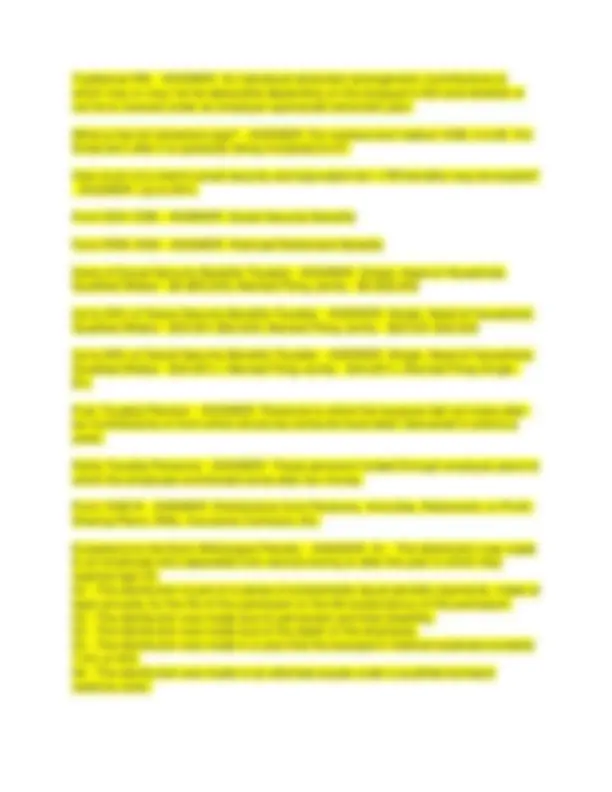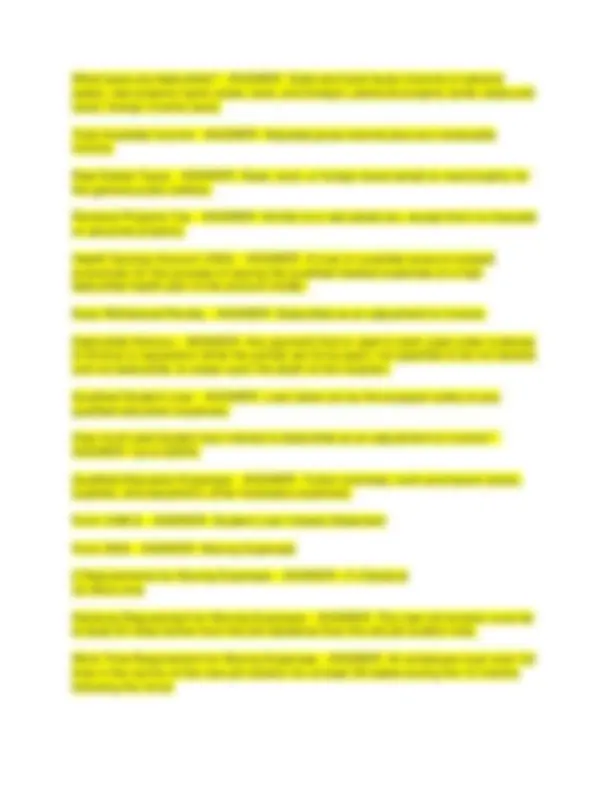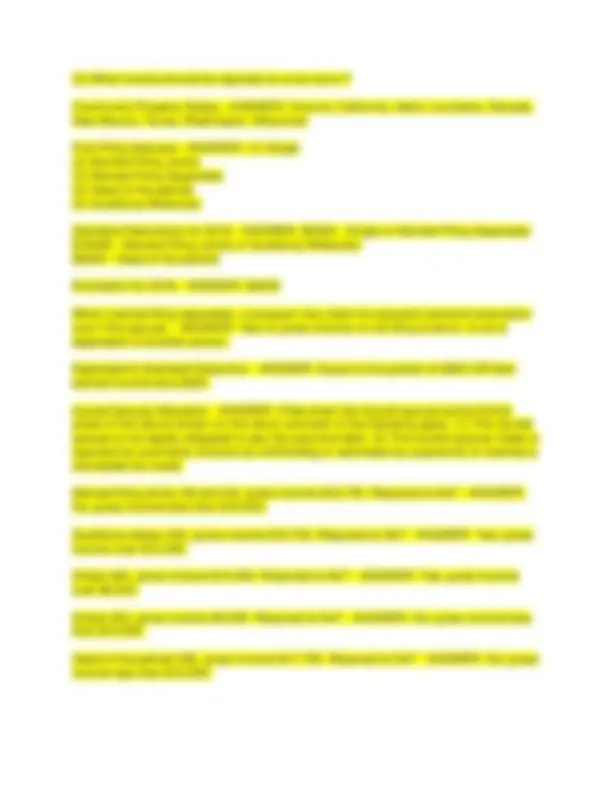



















Study with the several resources on Docsity

Earn points by helping other students or get them with a premium plan


Prepare for your exams
Study with the several resources on Docsity

Earn points to download
Earn points by helping other students or get them with a premium plan
Community
Ask the community for help and clear up your study doubts
Discover the best universities in your country according to Docsity users
Free resources
Download our free guides on studying techniques, anxiety management strategies, and thesis advice from Docsity tutors
H&R Block Income Tax Course Questions With Answers 2025.pdf
Typology: Exams
1 / 25

This page cannot be seen from the preview
Don't miss anything!


















Due Diligence - ANSWER- Requirements that tax professionals must follow when preparing income tax returns. Estimated Tax - ANSWER- The amount of tax a taxpayer expects to owe for the year after subtracting expected amounts withheld and certain refundable credits. Estimated Tax Voucher - ANSWER- A statement by an individual of (1) the amount of income tax he estimates he will incur during the current taxable year on income that is not subject to withholding, (2) the excess amount over that withheld on income which is subject to withholding, and (3) his estimated self-employment tax. Exemption from Withholding - ANSWER- Status claimed on Form W-4 directing the employer not to withhold federal income taxes from the employee. Underpayment Penalty - ANSWER- If a taxpayer did not pay enough tax on a timely basis during the year, he may be required to pay an underpayment penalty. Two Ways to Pay as You Go - ANSWER- Withholding and Estimated Tax Payments Form W- 4 - ANSWER- Employee's Withholding Allowance Certificate Form 4868 - ANSWER- Application for Automatic Extension of Time To File U.S. Individual Income Tax Return Amended Return - ANSWER- A tax return filed on Form 1040X after the original return has been filed. Closed Year - ANSWER- A tax year for which the statute of limitations has expired. Open Year - ANSWER- A taxable year for which the statute of limitations has not yet expired. Failure-to-File Penalty - ANSWER- Generally 5% for each month or part of a month the return is late, but not more than 25% of the tax not paid. Failure to File - ANSWER- Taxpayer fails to file the return by the due date, and there is a balance due. Form 1040X - ANSWER- Amended U.S. Individual Income Tax Return
When can an amended return be filed? - ANSWER- Within three years of the date the original return was filed, or within two years of the date the tax was paid, whichever is later. Can the 1040X be e-filed? - ANSWER- No. Portfolio Income and Losses - ANSWER- Those from such sources as dividends, interest, capital gains and losses, and royalties. Schedule E - ANSWER- Supplemental Income and Loss Royalty - ANSWER- Payments received for the right to extract natural resources from the taxpayer's property or to use a taxpayer's literary, musical, or artistic creation. Annuity - ANSWER- A series of payments under a contract made at regular intervals over a period of more than one year. Beneficiary - ANSWER- The owner or recipient of funds in an account, such as an IRA, or from an insurance policy or will. Contribution - ANSWER- When a person puts money into a retirement plan. Defined Benefit Plan - ANSWER- An employee benefit plan that provides determinable benefits not based on employer profits. Defined Contribution Plan - ANSWER- An employee benefit plan that provides a separate account for each person covered and pays benefits based on account earnings. Disability Pension - ANSWER- A taxable pension from an employer-funded disability plan or a disability provision of a retirement plan. Distribution - ANSWER- When a person takes or receives money from a retirement plan. Pension - ANSWER- Generally a series of definitely determinable payments made to a taxpayer after retirement from work. Rollover - ANSWER- A qualified transfer of funds from one tax-favored account to another, usually of the same type. Roth IRA - ANSWER- A type of individual retirement arrangement in which contributions are not tax deductible, earnings grow tax deferred, and qualified withdrawals are tax free.
07 - The distribution was made in a year an unemployed taxpayer paid health insurance premiums. 08 - The distribution was made to pay qualified higher education expenses for the taxpayer, spouse, their child, or their grandchild. 09 - The distribution was made to pay qualified first-time, home-buying expenses. 10 - The distribution was made due to an IRS levy of the qualified plan. 11 - The distribution was made to a reservist while serving on active duty for at least 180 days. 12 - Other. 401(k) Plan - ANSWER- Deferred compensation plan available through a wide range of employers. Contributions to a 401(k) plan are tax deferred to the employee. Distributions from the plan are taxed as ordinary income to the recipient when received. Roth IRA - ANSWER- A type of individual arrangement in which contributions are not tax deductible, earnings grow tax deferred, and qualified withdrawals are tax free. Traditional IRA - ANSWER- An individual retirement arrangement, contributions to which may or may not be deductible depending on the taxpayer's AGI and whether or not he is covered under an employer-sponsored retirement plan. Earnings within a traditional IRA grow tax-deferred. Distributions from a traditional IRA are taxable except to the extent they represent nondeductible contributions. Qualified Plan - ANSWER- A plan which is eligible for favorable tax treatment because it meets the requirements of both the following: IRC 401(a); the Employment Retirement Income Security Act of 1974. Nonqualified Plan - ANSWER- A plan that does not meet the requirements of IRC 401(a) and ERISA and do not qualify for favorable tax treatment. 403(b) Plans - ANSWER- A tax-advantaged retirement savings plan available for employees of: public education organizations; some non-profit organizations; cooperative hospital service organizations. Contribution - ANSWER- When a taxpayer puts money into an IRA. Rollover - ANSWER- When a taxpayer moves money from one IRA to another. Three Sets of Rules for IRAs - ANSWER- Taxpayers who are active participants in employer-maintained retirement plans at any time during the year; taxpayers who are not active participants, including joint filers whose spouses are not active participants; joint filers who are not active participants, but whose spouses are active participants. American Opportunity Credit (AOC) - ANSWER- Credit for qualifying education expenses available for tax years 2009 through 2012. The AOC may be partially refundable.
Credits - ANSWER- Reductions of tax liability allowed for various purposes to taxpayers who meet the qualifications. Some credits are refundable; that is, the IRS will send the taxpayer a refund for any amount in excess of the tax liability. Some credits are nonrefundable; that is, they can only reduce tax liability to zero. Some credits may be carried to other tax years. Lifetime Learning Credit - ANSWER- A nonrefundable credit equal to 20% of the first $10,000 of qualified higher education tuition and fees paid during the year on behalf of the taxpayer, his spouse, or his dependents. Nonrefundable Credit - ANSWER- A credit which cannot exceed the taxpayer's tax liability. Refundable Credit - ANSWER- A credit for which the IRS will send the taxpayer a refund for any amount in excess of the taxpayer's tax liability. Tuition and Fees Deduction - ANSWER- An above-the-line deduction of up to $4, per tax return for qualified tuition and course-related expenses. Requirements to Claim the AOC - ANSWER- The taxpayer pays qualified education expenses of higher education; the qualified education expenses are paid for an eligible student; the eligible student is the taxpayer, spouse, or dependent for whom the taxpayer actually claims an exemption. Modified Adjusted Gross Income (MAGI) - ANSWER- AGI plus foreign earned income exclusion, foreign housing exclusion, foreign housing deduction, income excluded by residents of Puerto Rico and American Samoa. Eligible Educational Institution - ANSWER- Any college, university, vocational school, or other postsecondary educational institution eligible to participate in a student aid program administered by the US Department of Education. Reduction of Qualified Educational Expenses - ANSWER- Qualified expenses must be reduced by any nontaxable: scholarships; grants; veteran's or military educational benefits; any other nontaxable benefits. Eligible Student - ANSWER- The student has not claimed an AOC in any four earlier tax years; the student had not completed the first four years of postsecondary education before 2011; the student was enrolled at least half-time in a program leading to a degree for at least one academic period beginning in 2011; the student had not been convicted of any federal or state felony for possessing or distributing a controlled substance as of the end of 2011.
Special-Needs Child - ANSWER- A child who the state has determined should not be returned to his parents' home and who probably will not be adopted unless special assistance is provided to the adopting family. Nonbusiness Energy Property Credit - ANSWER- Applies to improvements such as adding insulation, energy-efficient exterior windows and doors, and energy-efficient heating and air conditioning systems. FICA - ANSWER- The law that provides for social security and medicare benefits. This program is financed by payroll taxes imposed equally on the employer and employee. Schedule C - ANSWER- Profit or Loss From Business Schedule SE - ANSWER- Self-Employment Tax When are education expenses not deductible? - ANSWER- If the education is required to meet the minimum educational requirements in effect when the taxpayer first obtained the job or if it qualifies him for a new trade or business. Are tax preparation fees deductible? - ANSWER- Yes Hobby - ANSWER- An activity not entered into for profit. What portion of hobby expenses are deductible? - ANSWER- The portion up to the amount of income from the hobby that is reported on the tax return. Are funeral expenses deductible? - ANSWER- No Is homeowner's or renter's insurance deductible? - ANSWER- No Are gambling losses deductible? - ANSWER- Only to the extent of winnings reported as income. Itemized Deductions - ANSWER- Certain personal expenditures allowed as deductions from adjusted gross income. Schedule A - ANSWER- Itemized Deductions Sections on Schedule A - ANSWER- Medical and dental expenses; taxes you paid; interest you paid; gifts to charity; casualty and theft losses; job expenses and certain miscellaneous deductions; other miscellaneous deductions. What portion of medical and dental expenses is deductible? - ANSWER- To the extent they exceed 7.5% of the taxpayer's adjusted gross income.
What taxes are deductible? - ANSWER- State and local taxes (income or general sales); real property taxes (state, local, and foreign); personal property taxes (state and local); foreign income taxes. Total Available Income - ANSWER- Adjusted gross income plus any nontaxable income. Real Estate Taxes - ANSWER- State, local, or foreign taxes levied on real property for the general public welfare. Personal Property Tax - ANSWER- Similar to a real estate tax, except that it is imposed on personal property. Health Savings Account (HSA) - ANSWER- A trust or custodial account created exclusively for the purpose of paying the qualified medical expenses of a high deductible health plan of the account holder. Early Withdrawal Penalty - ANSWER- Deductible as an adjustment to income. Deductible Alimony - ANSWER- Any payment that is: paid in cash; paid under a decree of divorce or separation while the parties are living apart; not specified to be not taxable and not deductible; to cease upon the death of the recipient. Qualified Student Loan - ANSWER- Loan taken out by the taxpayer solely to pay qualified education expenses. How much paid student loan interest is deductible as an adjustment to income? - ANSWER- Up to $2500. Qualified Education Expenses - ANSWER- Tuition and fees; room and board; books, supplies, and equipment; other necessary expenses. Form 1098-E - ANSWER- Student Loan Interest Statement Form 3903 - ANSWER- Moving Expenses 2 Requirements for Moving Expenses - ANSWER- (1) Distance (2) Work time Distance Requirement for Moving Expenses - ANSWER- The new job location must be at least 50 miles farther from the old residence than the old job location was. Work Time Requirement for Moving Expenses - ANSWER- An employee must work full time in the vicinity of the new job location for at least 39 weeks during the 12 months following the move.
Qualifying Relative - ANSWER- A person who bears a certain relationship to the taxpayer for whom the taxpayer provides more than one-half support for the year, whose gross income for the year is less than the exemption amount, and who is not claimed as a qualifying child of any taxpayer. Qualifications for the Child Tax Credit - ANSWER- (1) The taxpayer must have a qualifying child. (2) The qualifying child must be under the age of 17 at the end of the year. (3) The qualifying child must be a dependent on the taxpayer's return. (4) The qualifying child must be a US citizen. Is the child tax credit refundable? - ANSWER- No Is the additional child tax credit refundable? - ANSWER- Yes Qualifications for the Additional Child Tax Credit - ANSWER- (1) Earned income exceeding $3000. (2) Three or more qualifying children. Maximum Earned Income Credit - ANSWER- $ Qualifications for Earned Income Credit - ANSWER- (1) Have a valid SSN. (2) Not filing married filing separately. (3) Be a US citizen. (4) Not file Form 2555. (5) Investment income of $3150 or less. (6) Have earned income. Qualifications for EIC without QC - ANSWER- (1) Between 25 and 65 years old. (2) Cannot be claimed as a dependent by another taxpayer. (3) Not a QC of another person. (4) Live in US over half the year. (5) AGI of less than $13660 ($18740 if MFJ). Qualifications for EIC with QC - ANSWER- (1) Have a QC. (2) QC not claimed by more than one person. (3) Not a QC of another person. (4) AGI less than: $36052 ($ MFJ) w/ 1 QC; $40964 ($46044 MFJ) w/ 2 QC; $43998 ($49078 MFJ) w/ 3+ QC. Relationship Test for QC - ANSWER- (1) Son, daughter, stepchild, eligible foster child, adopted child, or descendant. (2) Brother, sister, half-brother, half-sister, stepbrother, stepsister, or descendant. Age Test for QC - ANSWER- (1) Under 19 and younger than taxpayer. (2) Full-time student under 24 and younger than taxpayer. (3) Permanently and totally disabled. Residency Test for QC - ANSWER- Must have lived with taxpayer for more than half the year. Joint Return Test for QC - ANSWER- The QC cannot file a joint return, unless merely to claim a refund. Investment Income - ANSWER- Taxable and exempt interest; taxable dividends; net capital gain income; net nonbusiness rents and royalties; net passive income.
EIC Due Diligence - ANSWER- (1) Compute and submit an eligibility checklist. (2) Compute the amount of credit. (3) Comply with the knowledge requirement. (4) Retain records. Form 8867 - ANSWER- Paid Preparer's EIC Checklist Basis - ANSWER- A measure of the taxpayer's investment in property for tax purposes. Cost - ANSWER- Includes the cash paid, the fair market value of services rendered, and the fair market value of property traded in exchange for the property. Adjusted Basis - ANSWER- The original basis PLUS the cost of improvements; the cost of restoration after a casualty; assessments for local improvements MINUS any discount, rebate, or reimbursement of any portion of the purchase price; insurance reimbursements for property damages; the amount of casualty or other losses deducted on the return for any year; depletion or depreciation allowed or allowable; any gain that is not reported in the year realized. Holding Period - ANSWER- The length of time an asset has been owned. Tax Rate of Long-Term Capital Gains - ANSWER- 15% Maximum Rate - ANSWER- 28%. Applies to long-term gain from the sale of collectibles; certain gain from the sale of 1202 stock, also called qualified small business stock. Form 1099-B - ANSWER- Stocks or bonds sold through a broker. Capital Gain Distributions - ANSWER- Amounts paid by mutual funds, regulated investment companies, and real estate investment trusts. Mutual Fund - ANSWER- (1) An open-ended investment company that invests money of its shareholders in a usually diversified group of securities of other corporations. (2) A company that is in the business of buying and selling stocks and sharing its income with those invested in it. Nontaxable Distributions - ANSWER- Stock dividend distributions that are not taxable. Ordinary Dividends - ANSWER- Paid out of the earnings and profits of the corporation. Ordinary Income (Loss) - ANSWER- Income that is fully includable in gross income and that does not have the characteristics of capital gain or loss. Qualified Dividends - ANSWER- Dividends received on shares of common stock held by the taxpayer for more than 60 days of the 120-day period beginning 60 days before the ex-dividend date.
Nonresident Alien - ANSWER- A person who is not a US citizen and does not live in the US, or lives in the US under a nonresident visa, or does not meet the substantial presence test. Requirements for Head of Household - ANSWER- (1) The taxpayer is unmarried or considered unmarried on the last day of the tax year. (2) The taxpayer paid more than half the cost of maintaining the household for the year. (3) The taxpayer maintains a household for either of the following: A qualifying child or relative who lived with the taxpayer for more than half the year; His mother or father for the entire year. Exceptions to the Head of Household Requirements - ANSWER- (1) Married Qualifying Child (2) Non-Relative Dependent (3) Multiple Support Agreements (4) Non-Resident Aliens Married Qualifying Child - ANSWER- The child of a taxpayer for head of household purposes cannot be married unless the taxpayer can claim an exemption for that child. Non-Relative Dependent - ANSWER- A dependent who meets the relationship test because they live in the same household with the taxpayer for the entire year cannot qualify the taxpayer for head of household status. The dependent must actually be related to the taxpayer. Married - But Unmarried for Tax Purposes - ANSWER- (1) The person must file a separate return from their spouse. (2) The person must have provided more than half the cost of maintaining their home for the tax year. (3) The home must have been the principal place of abode of the taxpayer and their dependent son, daughter, or eligible foster child for more than half the tax year. (4) The person's spouse must not have lived in the home at any time during the last six months of the tax year. Disadvantages of Married Filing Separately - ANSWER- (1) The standard deduction is $0 if the other spouse itemizes. (2) The effective tax rates are higher. (3) Many deductions and credits are phased out at lower income levels or disallowed completely. Requirements for Qualifying Widow(er) - ANSWER- (1) The taxpayer's spouse died in either of the tax years immediately preceding the current tax year. (2) The taxpayer paid over half the cost of maintaining their household which is the home of their dependent son, stepson, daughter, or stepdaughter for the entire year. Form 8332 - ANSWER- Release/Revocation of Release of Claim to Exemption for Child by Custodial Parent Tie-Breaker Rules for Dependents - ANSWER- (1) If only one person is the child's parent, the child is treated as the qualifying child of the parent. (2) If the parents do not file a joint return together but both parents claim the child, the IRS will treat the child as
the QC of the parent with whom the child lived for the longer period of time during the year. If the child lived with each parent the same amount of time, the IRS will treat the child as the QC of the parent with the highest AGI for the year. (3) If no parent can claim the child as a QC, the child is treated as the QC of the person with the highest AGI for the year. (4) If a parent can claim the child but no parent does claim the child, the child is treated as the QC of the person who had the highest AGI for the year. Scott is single. His daughter, Rita, is his qualifying child. They lived together for all of
Full-Time Student - ANSWER- An individual who is enrolled in a school for the number of hours or courses considered by the school to be full time. Multiple Support Agreement - ANSWER- A written declaration stating that the taxpayer will not claim an exemption for the individual in question for that taxable year. Noncustodial Parent - ANSWER- The person who is not the custodial parent of the child. Permanent and Total Disability - ANSWER- A disability that prevents an individual from engaging in any substantial gainful activity because of a medically determined physical or mental impairment. Physical Custody - ANSWER- The taxpayer with whom a child lives. Principal Place of Abode - ANSWER- The place that an individual considers to be his permanent home. Support - ANSWER- The total amount provided on behalf of an individual. Exemption Amount for 2016 - ANSWER- $ Five Tests For A Qualifying Child - ANSWER- (1) Relationship (2) Age (3) Residency (4) Support (5) Joint Return Ways A Qualifying Child Can Be Related To A Taxpayer - ANSWER- Son or daughter; Brother or sister; Adopted child; Eligible foster child; A descendant of any of these. Age of a Qualifying Child - ANSWER- Under 19 at the end of the year and younger than the taxpayer; A full-time student under 24 at the end of the year and younger than the taxpayer; Permanently and totally disabled. Four Tests For A Qualifying Relative - ANSWER- (1) Relationship or member of the household (2) Gross income (3) Support (4) Not a qualifying child Can a taxpayer who may be claimed by another person on their return claim a dependent? - ANSWER- No Items Considered In Determining A Dependent's Support - ANSWER- Food; lodging; clothing; grooming and personal care items; most medical and dental expenses,
including health insurance premiums; most education expenses; child and dependent care; transportation; recreational activities; capital items purchased for dependent's individual use. Amount of Child Tax Credit - ANSWER- $1,000 per child. Qualifications for Child Tax Credit - ANSWER- (1) The taxpayer must have a qualifying child. (2) The qualifying child must be under the age of 17 at the end of the year. (3) The qualifying child must be claimed on the taxpayer's return. (4) The qualifying child must be a US citizen, US national, or resident of the US. Child Tax Credit Income Phaseout Levels - ANSWER- $75,000 - Single, Head of Household, Qualifying Widow(er) $110,000 - Married Filing Jointly $55,000 - Married Filing Separately Michael and Darla are married and have a daughter, Kayla (14). They all lived together for all of 2011. Kayla had no income. Qualifying child or relative? - ANSWER- Qualifying Child Dale (25) is single. His brother, Jeff (27), lived with him for all of 2011. Jeff earned $3,000, all from wages, and had no other income. Dale provided more than half of Jeff's support. Jeff is not permanently or totally disabled. No one else lived with Dale. Qualifying child or relative? - ANSWER- Qualifying Relative Cassandra is single. Her son, William (3), lived with her for all of 2011. William had no income. Qualifying child or relative? - ANSWER- Qualifying Child Harold and Helen are married and have a son, Hank (22). Hank is a full-time student. Hand earned $3,800, all from wages, and had no other income. Harold and Helen provided 80% of Hank's support. Hank lives on campus while school is in session. During the summer, Hank lives with Harold and Helen. Qualifying child or relative? - ANSWER- Qualifying Child Megan (27) is single. Her cousin, Pam (29), moved in with her in February of 2011. Pam earned $3,300, all from wages, and had no other income. Megan provided 60% of Pam's support. Pam is not permanently or totally disabled. No one else lived with Megan. Qualifying child or relative? - ANSWER- Neither Martin is single. His mother, Agnes (61), came to live with him in August of 2011. Agnes earned $14,000, all from wages, and had no other income. Martin provided 25% of Agnes' support. Agnes is not permanently or totally disabled. No one else lived with Martin. Qualifying child or relative? - ANSWER- Neither Teresa is single. Her daughter, Roberta (21), lived with her for all of 2011. Roberta is not a full-time student. Roberta earned $1,700, all from wages, and had no other
claim her. Kevin is not married. Orville, Marsha, and Kevin are all US citizens. Can Orville and Marsha claim Kevin as a dependent? - ANSWER- No Mai is single. Lee is her qualifying child. No one can claim Mai on their tax return. Lee is married to Sonja. Neither nor Sonja are required to file a tax return. Lee had no income. Sonja would have a very small tax liability if they filed separately. Lee and Sonja will not be filing a joing return. Mai, Lee, and Sonja are all US citizens. Can Mai claim Lee as a dependent? - ANSWER- Yes Community Income - ANSWER- Income of a married couple, living in a community property state, that is considered to belong equally to each spouse, regardless of which spouse receives the income. Community Property - ANSWER- Property considered to belong in equal shares to a husband and wife. Dependent - ANSWER- An individual whose personal exemption may be claimed on another person's income tax return. Joint Return - ANSWER- A return combining the income, exemptions, credits, and deductions of a husband and wife. Married Filing Jointly - ANSWER- The filing status used by a man and a woman who are married at the end of the tax year and not legally separated under a final decree of divorce or separate maintenance and who record total income, exemptions, and deductions of both spouses on one tax return. Married Filing Separately - ANSWER- The filing status used by a married couple who chooses to record their respective incomes, exemptions, and deductions on separate individual tax returns. Standard Deduction - ANSWER- A base amount of income not subject to tax. Three Factors That Determine The Filing Requirement For Nondependents - ANSWER- (1) Marital Status (2) Age (3) Gross Income What day is marital status determined? - ANSWER- The last day of the tax year. Four Legal Standards Of A Common-Law Marriage - ANSWER- (1) The parties must have the legal capacity to marry. (2) Single parties must have the current intent to marry. (3) The couple must live together as husband and wife. (4) The parties must publicly present themselves as husband and wife. Two Aspects To Determining Gross Income - ANSWER- (1) Who owns the income?
(2) What income should be reported on a tax return? Community Property States - ANSWER- Arizona, California, Idaho, Louisiana, Nevada, New Mexico, Texas, Washington, Wisconsin Five Filing Statuses - ANSWER- (1) Single (2) Married Filing Jointly (3) Married Filing Separately (4) Head of Household (5) Qualifying Widow(er) Standard Deductions for 2016 - ANSWER- $6300 - Single or Married Filing Separately $12600 - Married Filing Jointly or Qualifying Widow(er) $9300 - Head of Household Exemption for 2016 - ANSWER- $ When married filing separately, a taxpayer may claim his spouse's personal exemption only if the spouse: - ANSWER- Has no gross income; Is not filing a return; Is not a dependent of another person. Dependent's Standard Deduction - ANSWER- Equal to the greater of $950 OR their earned income plus $300. Injured Spouse Allocation - ANSWER- Filed when the injured spouse wants his/her share of the refund shown on the return and both of the following apply: (1) The injured spouse is not legally obligated to pay the past-due debt. (2) The injured spouse made or reported tax payments (income tax withholding or estimated tax payments) or claimed a refundable tax credit. Married filing jointly (48 and 44), gross income $16,750. Required to file? - ANSWER- No; gross income less than $19,000. Qualifying widow (48), gross income $16,750. Required to file? - ANSWER- Yes; gross income over $15,300. Single (64), gross income $10,000. Required to file? - ANSWER- Yes; gross income over $9,500. Single (65), gross income $9,000. Required to file? - ANSWER- No; gross income less than $10,950. Head of household (58), gross income $11,750. Required to file? - ANSWER- No; gross income less than $12,200.